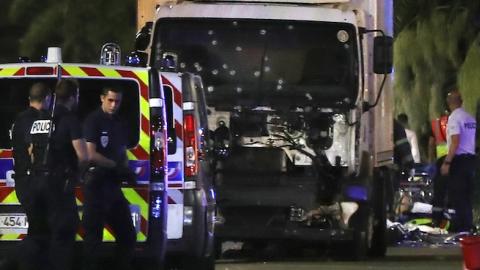After the horror of Nice, Israelis stand in solidarity with the people of France. When we see children and loved ones mowed down during an evening of celebration, our hearts break. We pray for the speedy recovery of the injured and mourn with the families of the victims.
But expressions of sympathy and solidarity aren’t enough. As the terrorist threat evolves, so, too, must our response. In Nice, the use of a truck as the murder weapon shows how terrorism is constantly developing new ways to inflict mass casualties.
Israel has bitter experience of this. The devastation in Nice was on a vast scale, but the method of attack is painfully familiar. Since October, 44 terrorist attacks have used motor vehicles as a weapon against Israelis.
In recent months, a new generation of terrorists radicalized on social media has launched more than 300 attacks in Israel using knives, guns and vehicles. Palestinian social media, and sometimes even official media, have published a flood of material glorifying the knife and the car as a weapon. The same is true of the jihadist groups murdering civilians in France and elsewhere around the world.
No longer do these people need training camps, bomb-making expertise or even an order. All they need is an internet connection, incitement and the desire to kill.
In this digital age, terror cannot be met with an analog response. We need to keep up, and Israel has experience and expertise to share.
When Palestinian terror groups pioneered plane hijacking, Israel pioneered rigorous security procedures for our airports and airlines. At the time, we were accused of undermining freedoms and criminalizing the innocent. Few would question the need for those procedures today.
When Israel first used drones to target terrorist leaders, we were accused of “extrajudicial killing.” Today these techniques are widely used in the fight against Islamic State and al Qaeda.
We’ve also modified our built environment, discreetly but deliberately, to protect civilian life. When, in 2014, a Palestinian terrorist attempted to ram his car into Israelis at a bus stop, he was stopped by a concrete bollard. Getting out of his car, the attacker still managed to kill one victim using a knife. But the body count could have been far higher.
Other countries now place bollards outside high-profile targets—at the White House in Washington, Westminster in London and high-risk embassies in major cities around the world. But when the enemy views children watching fireworks as a target, we need to adapt again.
Critics complain that such defensive actions compromise civil liberties and feed an atmosphere of fear. Yet the threat cannot be wished away, not when the ultimate civil liberty—the right to celebrate Bastille Day, to attend a rock concert, a nightclub or dine at a restaurant without fear of death—is under attack. Preserving these freedoms and civil liberties while responding to terror is a challenge for any country, especially a democracy.
We need tools to work with greater agility and speed against potential terrorists. Intelligence agencies must be given greater resources to identify and interpret the flood of data as quickly and efficiently as they can. This necessarily involves an element of profiling, building on an analysis of those most likely to be radicalized. In an age when the internet has turned yesterday’s disturbed loner into today’s radicalized sleeper cell, social-media companies must also take responsibility and play a role.
Beyond protective measures, we need new and innovative frameworks to work together and present a united front among Muslims, Christians and Jews. One of the first victims in Nice was a Muslim woman. Islamist terrorists have even struck Islamic holy sites in Medina, Saudi Arabia.
Muslim, Christian and Jew must be engaged in the defeat of terrorism. Cooperation already takes place under the radar between Israel, Western countries and Arab states. In a fight that is as much a war of propaganda as it is of weapons, the open involvement of Arab and Muslim countries would send a powerful and timely message.
Finally, the General Assembly of the United Nations should conduct a special session to bring nations and communities of all faiths together, openly and honestly, to do what is necessary to defeat this evil. Islamist terror targets us all, and together we must fight back.


















